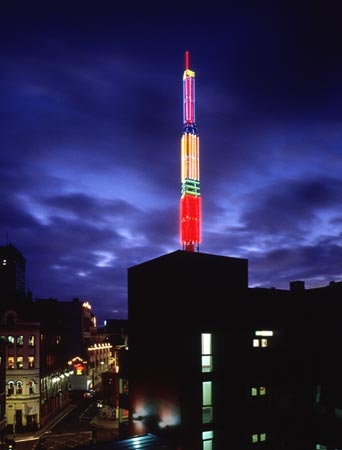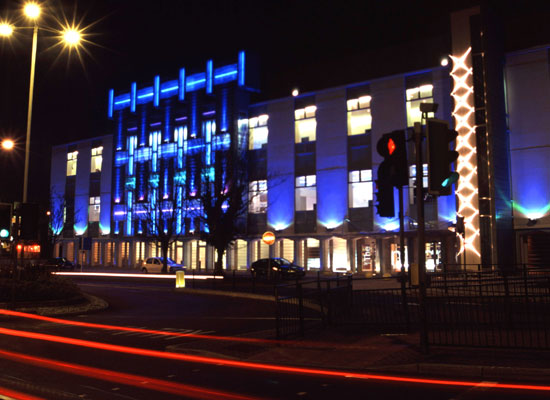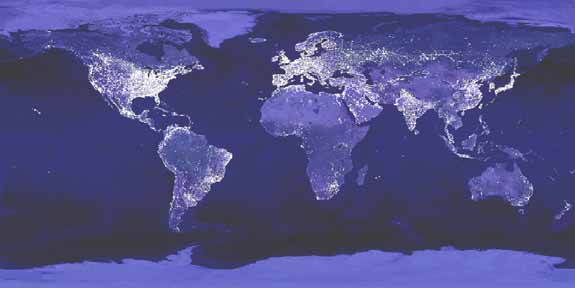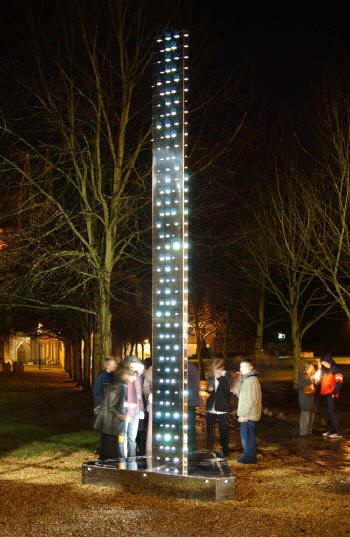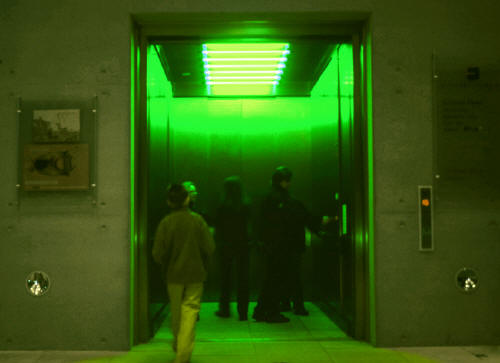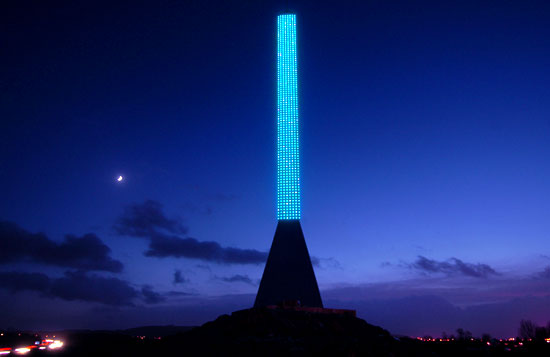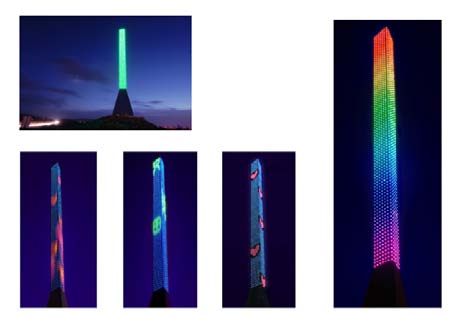|
|
| home | features | exhibitions | interviews | profiles | webprojects | gazetteer | links | archive | forum |
|
Travelling Light Peter Freeman Adapted from a talk given to the LIGHT: CRAFT symposium October 2008, Crafts Study Centre, University for the Creative Arts, Farnham, Surrey shortly after completing the interactive lighting installation 'Reflexive'. Peter Freeman has exhibited internationally and was recently commissioned to design lighting for The Exchange in Penzance. He lives in Penwith, Cornwall.
Introduction
Guardian Portrait, 1998
Itís interesting to be talking about using light as medium in the context of the Crafts Study Centre because I work between the boundaries of the conventional political enclosures of crafts and fine art. My practice has developed over the years from an initial interest in sculpture, through many years with the craft of making neon, to where I am now working with architects and urban planners in the built environment using different types of light sources. I'm part artist, lighting designer, crafts person, fabricator and computer programmer. Over the last few years nearly all of my work has been created as public art away from the sanctuary of galleries and teaching.
Oriel Gallery, Cardiff Craft Commission Room, 1992
I was not very academic at school and I ended up in the Art Room and then in Art college studying fine art sculpture in the 1970's. When I was at college there was a lot of interest in expanding the material possibilities of sculpture. At the time there was a lot of discussion about the nature of sculpture and its relationship to the space of the gallery. What started out as an interest in looking at the relationship between space and sculpture led me to be interested in using electric light as an autonomous expressive medium. Because instead of relying on reflected light to create form I found by using electric light my sculptures generated the light and filled the gallery spaces with their presence.
Toy Boy, Tib Street, Manchester, 1998
This was one of my first large public art commissions in 1998 for the Tib Street area of Manchester. It had been a run down area that was being developed into a cultural quarter for creative businesses and warehouse apartments. This sculpture, called Toy Boy, is bright and funky and fitted really well with the aspirations for the area. Its 12 metres high and sits on top of a car park lift tower giving it a height of over 50 metres. One of the revelations to me about this sculpture was the way that the sculpture affected the surrounding area. What I had expected was that the tower would create a visual sign and focal point for the area. What I hadnít really comprehended until it was installed was the way the sculpture then spread itís luminous magic of small reflections all over the area. As I walked round I found many small perfect reflections of the tower in all the shiny surfaces from car bumpers, shop windows and even the puddles.
My training
The first light sculptures I made while studying for my degree used discarded fluorescent lights that I bought from an army surplus shop. I then used the mainframe college computer to work out how to position them at random in my studio space. Bristol was a traditional art college with traditional sculpture-values and my experiments went down like a lead balloon, being met with horror and disbelief. I was very hurt at the time and unsurprisingly was awarded a 2.2 for my degree. As a result I left university feeling skill-less and a failure. After Bristol I spent a gap year travelling going to Turkey, Germany and America. In all these places I started noticing the potential of neon. In Turkey there was a huge profile of Attaturk in blue neon on the top of a hill. In Germany I saw some fantastic window displays that used different coloured tubes to create clouds and shoes. Then in America I visited Las Vegas and was completely blown away by the incredible neon architecture. During the day the buildings revealed themselves as shabby ordinary sheds but as darkness fell they became glowing palaces with glittering facades.
Spiral lamp, 1988 When I returned to the UK I decided to learn the craft of neon for myself, and enrolled on a scientific glass blowing course, followed by two years working for commercial neon companies before setting up my own studio in Londonís East end. Spiral Lamp (above) is one of the first lamps I made that I sold in shops like Liberty's in London. At this time I also received recognition from the Crafts Council and was awarded a setting up grant as well as getting on the list of selected makers. The lamps had been aimed at a domestic market, but when I started putting the lights into architectural settings I realised that this was their natural home. And it is in this area that I have continued to work and develop my ideas.
Interactive art and reflexive architecture
The Light House, Poole Art Centre, 2002
Interactivity has become an increasingly important aspect of my work. The advancement in technology - including mobile telephones and text messages - has made this a real possibility over the last few years. And the installations can be made to respond to environmental conditions, and human interaction. Interactivity also has advantages in that it helps to make the artwork more approachable, breaking down the traditional barriers between the work of art and viewer. I was commissioned to light the exterior of the Poole Art Centre. The installation uses the levels of carbon dioxide in the building to control the lighting effects on the outside of the building. The building has a natural ventilation system that is controlled by the carbon dioxide levels given off by people in the building. When the building is quiet and there is no performance, my lights gently change colour, but when the building is buzzing the carbon dioxide levels increase and the light responds by creating ripples of animated light. What is light?
Sunrise over Gwithian, West Cornwall. Courtesy Roger Shone
This is a picture of a sunrise over Gwithian. It is a local beauty spot near where I live in West Cornwall. This is the light from the sun that has bathed the world since the beginning of creation. For me looking over the sea and watching how the light plays between the sky and the water is a continuous inspiration in my work. But then some time later in the late nineteenth century a new human light was born. The credit for the first commercial incandescent electric light usually goes to Thomas Edison although it was really a product of the era with many scientists all over the world contributing. Then in the early part of the twentieth century a man called George Claude discovered how to make neon light. And suddenly man could light up the night skies.
Night sky from satellite Courtesy of NASA
This is one of my favourite pictures of the earth taken from a satellite at night. Itís interesting not only because of its beauty, but also because to me it reveals a complex relationship we have with light. This map reveals the way electric light is not only functional but also aspirational. The reason cities glow at night is not only because we need to see in the dark, but also because to glow and to be seen from space is an expression of progress and prowess. At one level it makes me very proud to be a human being at the beginning of a new millenium, but at another I see the destruction of the night which has consequences that we cannot imagine. It is also very sobering to look at the dark places on the map and to realise that the gift of light is very unevenly spread.
Inner
light
Luminous Motion, Winchester, 2002 Perhaps Iíve touched on it above but there is an aspect to light which is really one of the big areas of interest for me as an artist, and that is the subjective nature of light. This is the light that delights the eye, creating beauty and joy. It is the emotional part of light that has little to do with the science of light and the utilitarian act of illumination. I made this sculpture for the Winchester Light Art Project. It was installed at the end of November 2002. The sculpture uses mobile telephone technology and text messaging, enabling anyone to change the colour of the sculpture by sending text messages. I love the location of the sculpture just inside the cathedral grounds but close to the commercial centre. I wanted this work to form a dialogue between the language of the spiritual light that is part of the Cathedral and Christian tradition, and the secular commercial light that is part of the high street. I believe part of my remit, as an artist is to take the commercial light that is used to sell products and return it a purer aesthetic domain. There is a wonderful book that I read whenever I need inspiration by Arthur Zajonc, who is a professor of physics at Amherst College in America, called ĎCatching the Light Ė the entwined history of light and mindí. It deals convincingly and rationally with the subject of the inner and outer light in great depth. 'Two lights brighten our world. One is provided by the sun, but another answers to it Ė the light of the eye. Only through their entwining do we see; lacking either, we are blindÖ.The light of the mind must flow into and marry with the light of nature to bring forth a world'. As an artist Iím interested in using electric light to engage with this inner emotional light.
Colour Shift, Gallery Oldham, 2002
This picture is of an installation I made for a new gallery and museum in Oldham designed by architects Pringle Sharrat and Richards. There are two lifts on either side of a double height foyer in the entrance hall to the gallery. I was commissioned to create complementary light installations in both lifts. I filled one lift with green light and one lift with pink light. If you go up in the pink lift, as the doors close your eyes are saturated with pink light and your visual system tries to compensate. Two floors later when the doors open and you step out the world looks a shade of green because your eyes have over compensated and now have to readjust to the natural light. The reverse happens in the green lift, your eyes are saturated with green light and when the doors open the world looks pink. What was interesting to me was that when you go in the pink lift the pink light flatters the skin tones and everybody has a great complexion however when the doors open the world looks green and slightly unattractive. In the green lift the reverse is true the moment the doors close you realise you have probably made a mistake in taking the lift as all your companions look like green aliens. This is very odd and worrying but the pay off is that when the doors open the world looks pink and fantastic. The lifts have been a great success with school parties but the staff complain that instead of visiting the galleries the children just go round and round up and down riding the lifts.
Dystopic light
Travelling light, M5 Weston , 2004
The idea for Travelling Light (above), commissioned by Persimmon Homes and North Somerset District Council, was to create a beacon sculpture on the M5 that would mark the entrance to Weston super Mare and the South West of the UK. The other aim was to create a piece that would have the potential to amuse and surprise commuters as they drove past. One of the really big advances in lighting since I started using it as a medium has been the development of LEDs and the possibility of computer control. Travelling light is a mirror stainless steel column that is covered in a matrix of 2000 digitally controlled led pixels. This means that I can control each pixel and each pixel has the possibility to be any colour imaginable. Rather like a low-resolution video screen. So during the week the sculpture is a single colour gradually changing from day to day with a machine gun sparkle.
The light has special days. On Saturday it throws up rainbows. And Sunday itís a wonderful golden colour. However the sculpture knows exactly where it is in the year and has individual colour arrangements for special days like going up in flames on bonfire night. Space invaders on Halloween, and it is covered in a river of pink hearts on Valentines Day. There are also surprise programs for all the solar and some other calendar events of the year.
|



